The supply chain” has been getting a lot of blame lately.
It has taken the fall for everything from steel not getting to equipment manufacturers to cheese puffs not getting onto store shelves. The phrase “supply chain issues” gets more than 9.7 million Google hits. If you listen to any food company CEO speaking with stock analysts, you are almost certain to hear a reference to supply chain issues – especially if his or her company’s results were less than stellar.
But what does “supply chain issues” – or even the entire concept of “the supply chain” – mean, exactly?
In a provocative essay in the Oct. 4 issue of the New Yorker, Amy Davidson Sorkin argues that blaming the supply chain has become almost a copout: “Referring to supply-chain issues...can be a useful shorthand when a problem arises, but it’s an insufficient one.” In other words, almost every so-called “supply chain issue” has a fundamental root cause.
That root cause is usually labor. As Davidson Sorkin says in her essay: “What’s often at the heart of a supply-chain issue is a labor issue.”
Think about it. The supplies from overseas, of stainless steel, computer chips and everything else needed to make processing and packaging machinery that are languishing on overseas freighters – it’s because there aren’t enough people to staff the ports. The ingredients that aren’t making it to the processing plants – there aren’t enough workers in the plants that process the ingredients. The products from those plants aren’t making it onto store shelves for the same reason. And of course, everything is exacerbated by a lack of truck drivers.
Now, the overwhelming temptation is to blame all the world’s supply chain problems on the pandemic. And it’s true that many of the problems we’re seeing came about during the height of a pandemic that is, regrettably, not over yet. But it’s also true that many of those problems were not so much caused by the pandemic as exposed by them.
It’s always been tough to get people to drive long-haul trucks or to work in a dank, freezing-cold plant, slicing up hog carcasses. The pandemic simply intensified that problem. It did so, first by making enough workers sick so that the pressure on the remaining ones ratcheted up, then by giving them enough options – through other jobs or heightened unemployment benefits – that they had time to at least rethink their current job trajectories.
Perhaps the purest form of using the pandemic and the “supply chain” to mask labor problems can be seen in the United Kingdom, where supermarket shelves are beginning to go bare and stores are warning that consumers may not be able to find everything for a traditional Christmas meal. Things are so bad over there that the meat industry is calling for prisoners to be recruited from behind bars to work in meat processing plants.
Yes, Britain has been hit hard by the pandemic. But a big part of the “supply chain” problem stems from Brexit, Britain’s withdrawal from the European Union, which chased low-income holders of EU passports out of the country. All of a sudden, the Romanians and Poles who drove the trucks and staffed the factories weren’t around anymore, and guess who didn’t want to take their places?
Of course, supply chain problems extend to factors beyond labor – at least in theory. One of the biggest problems came to light early in the pandemic, when processors had a lot of trouble switching from foodservice to retail production. This exposed one of the weaknesses of the just-in-time model. In normal times, keeping as little inventory around as possible worked to keep costs down; faced with a massive shift in demand, that system broke down.
But if you look hard enough, you can find a labor issue there, too. The point of just-in-time operation is spending less money: on storage, and on employees to stock and destock goods in that storage. Employees weren’t needed for that, until all of a sudden they were.
In other words, most “supply chain issues” won’t be resolved until the people issues that undergird them are resolved. In the long run, that may well entail automation, to do jobs that not enough humans can be found to do. In the short run, it will require making those jobs more attractive through any means necessary – including higher wages. The supply chain is only as good as its human links.


